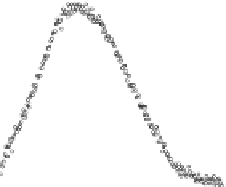Biomedical Engineering Reference
In-Depth Information
TCC
20
15
4 pA
10
TXA
5
0
-5
2 pA
53.61
53.62
53.63
53.64
0.1 s
Time (s)
Fig. 6.10
Triangular-shaped conductance events induced by thiocolchicoside (TCC) and taxol
(TXL)-A (TXA), both at 90
100mV. Both traces were filtered at 20kHz.
The lower plot shows higher noise due to its presentation (current axis) at an amplified scale. In
a high-resolution plot (shown on the right-hand side of the
arrow
) of a single event only with
showing individual points (in Origin 8.5 plot) we observe all points (
open circles
) with increas-
ing and decreasing values of conductance, respectively, at both left and right lateral sides of the
chemotherapy drug-induced triangular conductance events
µ
M.
pH
=
5
.
7,
V
=
current levels in TCC or TXL-induced conductance events strongly indicates the
existence of a pore whose cross-sectional area fluctuates with time.
The chemotherapy drug-induced broken regions of a membrane or the lipid-lined
toroidal pores behave exactly like regions without the hydrophobic membrane core.
Any material which avoids contact with the membrane environment (specifically
the membrane inner hydrophobic core) may find these pores to be favorable regions
for passage. It is predicted that the pore-inducing agents reside behind the lipids.
Any material passing through the pore can therefore avoid direct interactions with
the pore-inducing agents. A molecular dynamics simulation equivalent to the one
explained in Chap.
5
may help to elucidate the quantitative nature of possible inter-
actions (electrostatic, van der Waals, etc.) between nanoparticles and lipid or pore-
inducing agents, e.g., chemotherapy drugs (see Fig.
6.10
). From the discussion of the
results presented in the previous section, it appears most likely that such interaction
energies are strongly dependent on the electro-chemical properties of the nanopar-
ticles willing to cross through specific membranes. It is also worth mentioning that
certain nanoparticles, such as silica nanoparticles, are likely to experience weak
interactions, while others, such as polycationic polymer nanoparticles, are likely
to experience stronger interactions and show better binding with lipids. Nanopar-
ticles with a neutral or non-binding propensity toward lipids can be easily driven
through the chemotherapy drug-induced broken (toroidal pores) type regions. This
is schematically diagrammed in Fig.
6.11
. With the absence of considerable binding
to membranes (due to a negligible value of
U
np-lip
,seeEq.
6.5
) these nanoparticles



















Search WWH ::

Custom Search